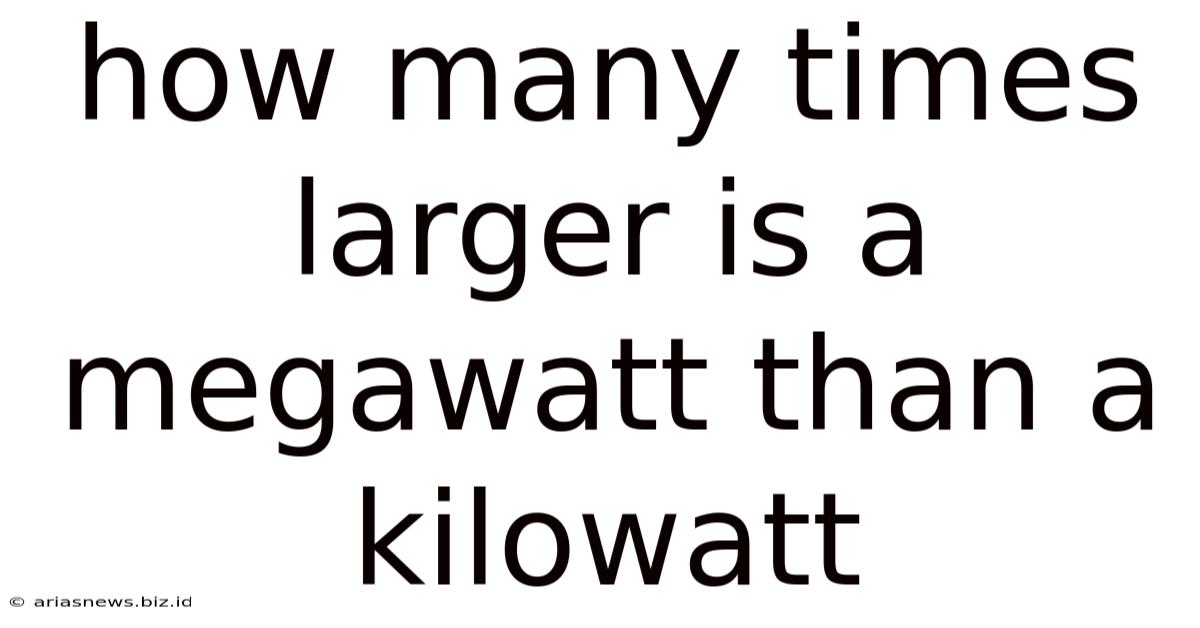How Many Times Larger Is A Megawatt Than A Kilowatt
Arias News
May 12, 2025 · 4 min read

Table of Contents
How Many Times Larger is a Megawatt Than a Kilowatt? Understanding Power Units
Understanding the difference between megawatts and kilowatts is crucial for anyone dealing with electricity, from homeowners comparing energy plans to engineers designing power grids. While both units measure power, their scales differ significantly. This article will delve deep into the relationship between megawatts and kilowatts, explaining the conversion factor, providing real-world examples to illustrate the magnitude of the difference, and exploring why understanding these units is essential in various contexts.
The Fundamental Difference: Prefixes and Powers of Ten
The core difference between megawatts (MW) and kilowatts (kW) lies in the prefixes "mega" and "kilo," which represent multiples of the base unit, the watt (W). The watt itself is a unit of power, representing the rate at which energy is transferred or converted.
-
Kilo (k): This prefix signifies a multiplier of 1000 (10<sup>3</sup>). Therefore, one kilowatt (kW) is equal to 1000 watts (W).
-
Mega (M): This prefix signifies a multiplier of 1,000,000 (10<sup>6</sup>). Consequently, one megawatt (MW) is equal to 1,000,000 watts (W).
The Conversion: Megawatts to Kilowatts and Vice Versa
From the definitions above, we can directly derive the conversion factor:
1 MW = 1000 kW
This means a megawatt is one thousand times larger than a kilowatt. Conversely:
1 kW = 0.001 MW
This simple conversion is fundamental to understanding power scales in various applications.
Real-World Examples Illustrating the Scale
To truly grasp the magnitude of the difference, let's examine some real-world examples:
Household Electricity Consumption: Kilowatts
A typical household appliance consumes power in the range of kilowatts. For example:
- A microwave oven: Might consume around 1 kW during operation.
- A refrigerator: Typically uses between 0.1 kW and 0.5 kW depending on size and model.
- A hair dryer: Can draw approximately 1.5 kW.
- A television: Usually consumes between 50 W and 200 W (0.05 kW to 0.2 kW).
Adding up the power consumption of all the appliances in a home, the total power demand might reach several kilowatts at peak times.
Power Plants and Large-Scale Generation: Megawatts
Power plants, on the other hand, generate electricity in the megawatt range. The scale is dramatically different:
- A small-scale wind turbine: Might produce around 1 MW of power.
- A large-scale wind turbine: Can generate up to 5 MW or even more.
- A nuclear power plant: Can generate hundreds of megawatts (e.g., 1000 MW or 1 GW).
- A coal-fired power plant: Usually produces power in the gigawatt range (1 GW = 1000 MW).
This demonstrates the sheer difference in power generation capacity. A single power plant can supply electricity to thousands, even millions, of households, while each household consumes electricity in the kilowatt range.
The Importance of Understanding Power Units in Different Contexts
Understanding the difference between megawatts and kilowatts is critical in several fields:
Energy Planning and Management:
Energy companies use megawatts and kilowatts to plan power generation, distribution, and consumption. This is crucial for grid stability and meeting electricity demand. Understanding peak demand in kilowatts helps to plan for sufficient megawatts of generation capacity.
Renewable Energy:
The capacity of renewable energy sources like solar panels and wind turbines is often expressed in kilowatts or megawatts. Understanding these units helps in assessing the potential contribution of renewable energy to the electricity grid. A homeowner might install a few kilowatt solar panels on their roof, while a large-scale solar farm will have a megawatt capacity.
Industrial Applications:
Large industrial facilities like factories and manufacturing plants consume electricity on a megawatt scale. Their power requirements need careful planning and management to ensure uninterrupted operation.
Electrical Engineering:
Electrical engineers work with these units extensively in designing power systems, calculating power loads, and ensuring safe and efficient energy transmission.
Comparing Energy Plans:
Homeowners choosing energy plans often encounter kilowatt-hour (kWh) as a unit of energy consumption. Understanding kilowatts helps interpret energy usage and costs.
Beyond Megawatts: Gigawatts and Beyond
The scale of power units doesn't stop at megawatts. For even larger power generation and consumption, we use gigawatts (GW), terawatts (TW), and beyond.
-
Gigawatt (GW): 1 GW = 1000 MW = 1,000,000 kW. Large power plants and national grids operate at the gigawatt scale.
-
Terawatt (TW): 1 TW = 1000 GW = 1,000,000 MW = 1,000,000,000 kW. This unit is relevant for discussing global energy consumption.
Conclusion: The Crucial Distinction Between Megawatts and Kilowatts
The difference between megawatts and kilowatts is not merely a matter of prefixes; it represents a vast difference in the scale of power. A megawatt is a thousand times larger than a kilowatt, reflecting the difference between the power consumption of a single household and that of a large power plant or industrial facility. Understanding this distinction is essential for various applications, from household energy management to large-scale power generation and distribution. Mastering the conversion and appreciating the magnitudes involved ensures effective communication, efficient planning, and informed decision-making in the energy sector and beyond. Whether you're a homeowner, an energy professional, or simply interested in the world of electricity, understanding these units is crucial for navigating the complexities of power in our modern world.
Latest Posts
Related Post
Thank you for visiting our website which covers about How Many Times Larger Is A Megawatt Than A Kilowatt . We hope the information provided has been useful to you. Feel free to contact us if you have any questions or need further assistance. See you next time and don't miss to bookmark.